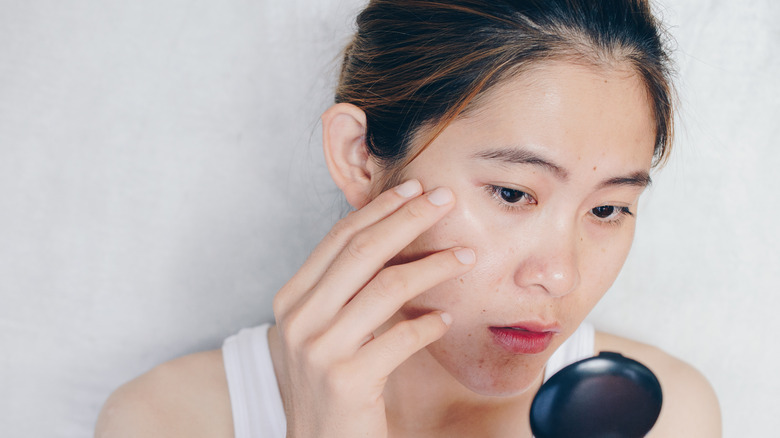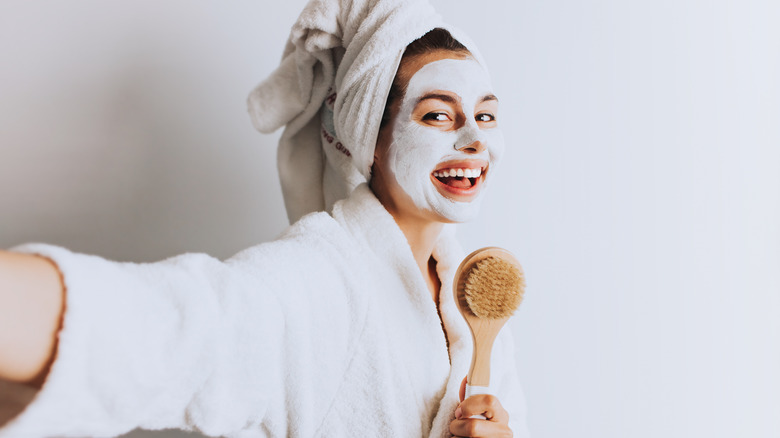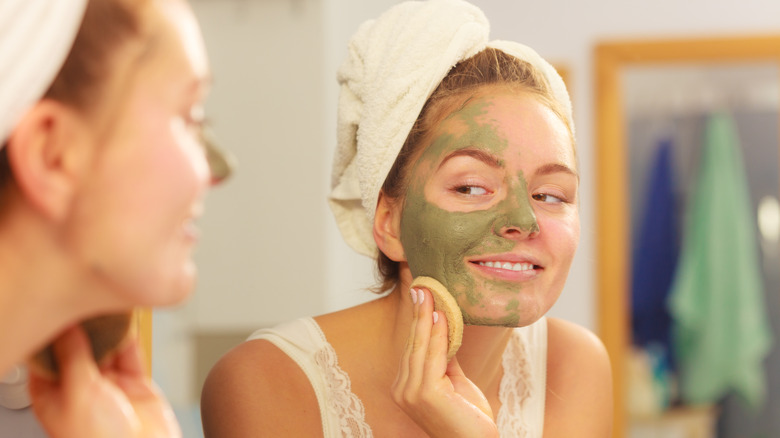The Best Type Of Face Mask To Get Rid Of Blackheads (And How To Apply It)
Little black spots — known as blackheads — are probably one of the last things you want popping up on your face, but if you're like most people, there's a good chance you've dealt with them at some point. Cleveland Clinic notes that while only 10% to 20% of adults have blackheads, nearly everyone has had them, whether in adolescence, during early adulthood, or later in life. These small, dark bumps are caused by clogged pores, and they get their black appearance from the way the light reflects off the trapped oil and dead cells.
Since blackheads are close to the skin's surface and so easy to spot, it can be tempting to pick and squeeze to try to remove them. However, many experts warn against this method. "Squeezing blackheads can traumatize the skin, introduce bacteria and damage the pore, which can spread debris and bacteria deeper into the tissue," dermatologist Dr. Hadley King told Insider. And unfortunately, those drugstore pore strips may not work either. "They are simply a temporary cosmetic fix," Adam Friedman, an associate professor of dermatology, proclaimed to Allure.
Still, you don't have to be stuck with blackheads forever. Some face masks can help get rid of and prevent these pesky clogged pores without damaging your skin.
Clay is your secret weapon for dealing with blackheads
A variety of tools, creams, and serums may promise to clear up blackheads, but one tried-and-true solution is the clay mask. A 2016 research article published in the journal Molecules confirmed that clay minerals can treat acne, including blackheads, when applied as a face mask. As Dr. Brooke Grant Jeffy, a board-certified dermatologist, explained to Byrdie, clay works by absorbing excess oil and tightening pores, stopping blackheads dead in their tracks and making existing blemishes appear smaller. It can also soothe inflammation, which can come in handy if you already gave in and picked at your blackheads.
Keep in mind, however, that not all clay masks are made equal. "In terms of important ingredients, look for kaolin and/or bentonite as superior ingredients for these types of masks," Dr. Neal Schultz, a dermatologist and the creator of BeautyRx, told Bustle. These ingredients are known to exfoliate and draw out impurities from the skin.
How to get the most out of your clay mask
Clay masks are among the most humble skincare essentials around, often sold as a super simple powder or in a tube with just a few other ingredients. Still, it's possible to mess them up — and that means you might mess up your skin. To use them correctly, skin researchers recommend heating up the face with warm water (or mixing the powdered clay with warm water) to open the pores and help dislodge sweat and gunk from the skin.
After applying your mask, notice how it changes on your skin. Sharon McGlinchey, a facialist and the creator of MV Organic Skincare, says there are three phases of a clay mask. "There's the damp phase where your skin drinks in the beneficial minerals from the outside," she shared with Allure. "Then you have the start of the dry phase, which exercises your capillaries and stimulates blood flow as the mask cools and contracts. But then there's the dry phase, which draws out moisture from the surface of your skin, causing dehydration and irritation." The key is to wash the mask off before it fully dries to avoid a parched complexion.
Then, be sure to apply your regular skincare, including a lotion or moisturizer. Follow up with another clay mask in a few days or up to a week to keep blackheads at bay.


